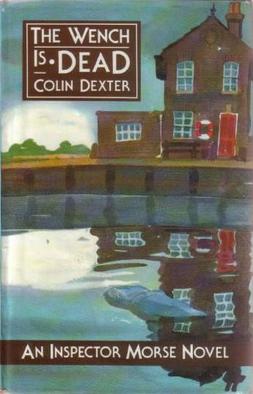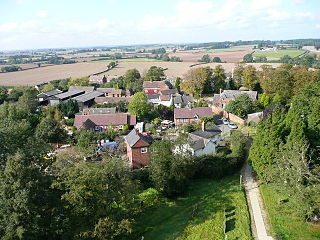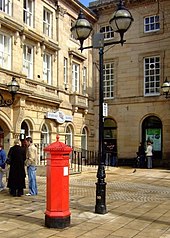
Stafford is a market town and the county town of Staffordshire, in the West Midlands region of England. It lies about 15 miles (24 km) north of Wolverhampton, 15 miles (24 km) south of Stoke-on-Trent and 24 miles (39 km) northwest of Birmingham. The town had a population of 71,673 in the 2021 census, It is the main settlement within the larger borough of Stafford which had a population of 136,837 (2021).

Chetham's Library in Manchester, England, is the oldest free public reference library in the English-speaking world. Chetham's Hospital, which contains both the library and Chetham's School of Music, was established in 1653 under the will of Humphrey Chetham (1580–1653), for the education of "the sons of honest, industrious and painful parents", and a library for the use of scholars. The library has been in continuous use since 1653. It operates as an independent charity, open to readers free of charge, Monday-Friday 09.00-12.30 and 13.30-16.30 by prior appointment. Tours of the Library for visitors are bookable online from 2 September 2019 via the Library website.

Ushaw College is a former Catholic seminary near the village of Ushaw Moor, County Durham, England, which is now a heritage and cultural tourist attraction. The college is known for its Georgian and Victorian Gothic architecture and listed nineteenth-century chapels. The college now hosts a programme of art exhibitions, music and theatre events, alongside tearooms and a café.

Weston-under-Lizard is a village and former civil parish, now in the parish of Blymhill and Weston-under-Lizard, in the South Staffordshire district of Staffordshire, England. It is known as Weston-under-Lizard to distinguish it from Weston-on-Trent. It should not be confused with the village of Weston, to the north east of Stafford. In 1961 the parish had a population of 294. On 1 April 1986 the parish was abolished and merged with Blymhill to form "Blymhill and Weston-under-Lizard".

The Weaver Hall Museum and Workhouse, Northwich, Cheshire, records the social, cultural and industrial history of west Cheshire. It was formerly known as the Salt Museum, reflecting its early focus on the history of salt extraction, a local industry dating back to Roman times. The museum was renamed Weaver Hall Museum and Workhouse in 2010 as its remit now extends to cover the broader history of the area and also the history of the building itself as a former workhouse.

The Leeds Library is the oldest surviving subscription library of its type in the UK. It was founded in 1768, following an advertisement placed in the Leeds Intelligencer earlier that year. The first secretary was Joseph Priestley. In 1779, James Boswell wrote, "In Leeds, where one would not expect it, there is a very good public library, where strangers are treated with great civility."

Swynnerton Hall is an 18th-century country mansion house, the home of Lord Stafford, situated at Swynnerton near Stone, Staffordshire. It is a Grade I listed building.

Wrottesley Hall is a 1923-built Grade II listed house in the civil parish of Perton, and historically part of Tettenhall in Staffordshire, England.

Caverswall Castle is a privately owned early-17th-century English mansion built in a castellar style upon the foundations and within the walls of a 13th-century castle, in Caverswall, Staffordshire. It is a Grade I listed building. The castle is large, with a floor area of 2,030 square yards (1,700 m2).
William Salt was a British banker in London, England, and a genealogist and antiquary in whose memory the William Salt Library in Stafford was founded.

The Wench Is Dead is a historical crime novel by Colin Dexter, the eighth novel in the Inspector Morse series. The novel received the Gold Dagger Award in 1989.
John Stevenson Salt was an English barrister, banker and land owner.

Clifton Campville is a village, former manor and civil parish in Staffordshire, England. It lies on the River Mease, about 10 miles (16 km) east of the City of Lichfield, 6 miles (10 km) west of Measham and 7 miles (11 km) north of Tamworth. The village lies close to Staffordshire's borders with Derbyshire, Leicestershire and Warwickshire. The parish, which includes Haunton village, had a population of 912 at the 2011 census. There is a fine gothic church, dedicated to St Andrew, and listed Grade I. The village pub, The Green Man, is also a historic building.

Black Ladies Priory was a house of Benedictine nuns, located about 4 km west of Brewood in Staffordshire, on the northern edge of the hamlet of Kiddemore Green. Founded in the mid-12th century, it was a small, often struggling, house. It was dissolved in 1538, and a large house was built on the site in Tudor and Jacobean styles by the Giffard family of Chillington Hall. Much of this is incorporated in the present Black Ladies, a large, Grade II*-listed, private residence.

The Shire Hall is a public building in Stafford, England, completed in 1798 to a design by John Harvey. Formerly a courthouse, it housed an art gallery which closed to the public in July 2017. The court rooms and cells are preserved. The building, its interiors, and the associated street furniture were grade II* listed on 17 December 1971, when it was described as "One of the finest public buildings in Stafford".

Thomas Peploe Wood was an English landscape painter. A number of his pictures are at the British Museum, the Victoria and Albert Museum, Staffordshire County Museum and the William Salt Library, Stafford.

The North Stafford Hotel is a Grade II* listed hotel in Stoke-on-Trent, Staffordshire, England, opposite the city's railway station, also a Grade II* listed building.

County Buildings is a municipal facility at Martin Street in Stafford, Staffordshire. The building, which is the meeting place for Staffordshire County Council, is a Grade II* listed building.

The Borough Hall is a municipal building in Eastgate Street, Stafford, Staffordshire, England. The borough hall, which formed the headquarters of Stafford Borough Council, is a Grade II listed building.

The Old Borough Library is a former public library in Stafford, Staffordshire, England, opened in 1914. It is a Grade II listed building.



















